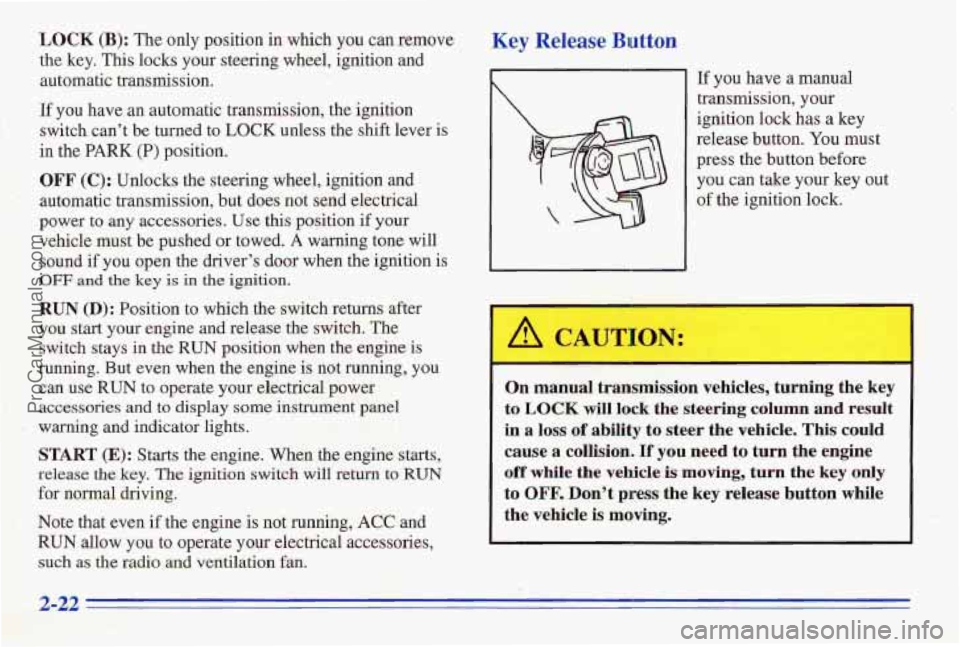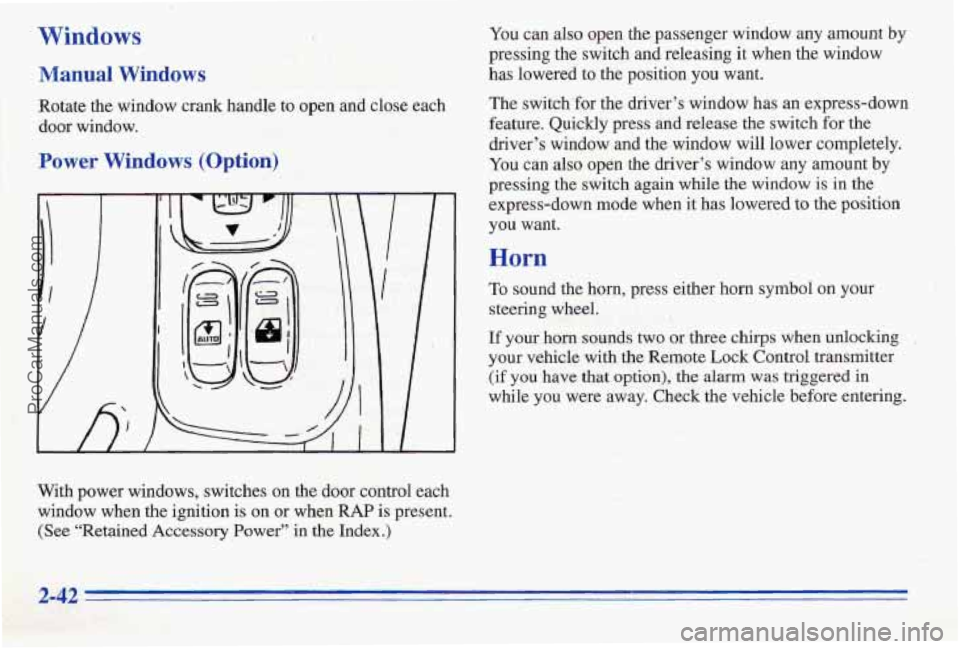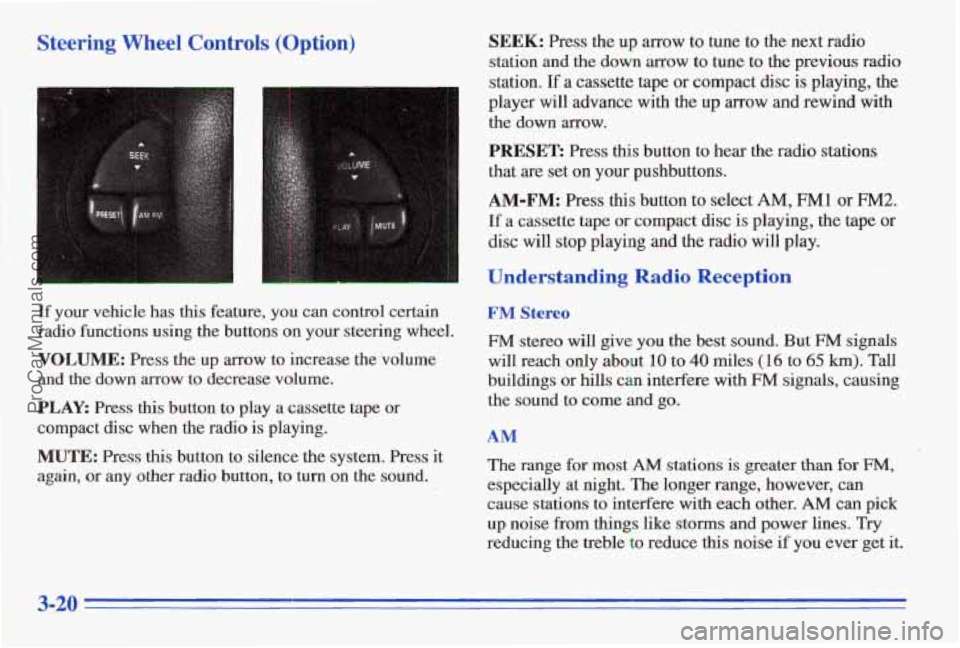power steering PONTIAC FIREBIRD 1996 Owners Manual
[x] Cancel search | Manufacturer: PONTIAC, Model Year: 1996, Model line: FIREBIRD, Model: PONTIAC FIREBIRD 1996Pages: 386, PDF Size: 19.18 MB
Page 71 of 386

LOCK (B): The only position in which you can remove
the key.
This locks your steering wheel, ignition and
automatic transmission.
If you have an automatic transmission, the ignition
switch can't be turned to
LOCK unless the shift lever is
in the PARK (P) position.
OFF (C): Unlocks the steering wheel, ignition and
automatic transmission, but does not
send electrical
power
to any accessories. Use this position if your
vehicle must be plashed or towed. A warning tone will
sound
if you open the driver's door when the ignition is
OFF and the key is in the ignition.
RUN (D): Position to which the switch returns after
you start your engine and release. the switch. The
switch stays in
the RUN position when the engine is
running. But even when the engine is not running, you
can use RUN to operate your electrical power
accessories and to display some instrument panel
START (E): Starts the engine. When the engine starts,
release the key. The ignition switch will return to RUN
for normal driving.
Note that even if the engine is not running,
ACC and
RUN allow you to operate your electrical accessories,
such as the radio .and ventilation fan.
I warning and indicator lights.
Key Release Button
If you have a manual
transmission, your
ignition lock has
a key
release button. You
must
press the button before
you can take your key out
of the ignition lock.
On manual transmission vehicles, turning the key
to
LOCK will lock the steering column and result
in a loss of ability to steer the vehicle. This could
cause a
collision. If you need to turn the engine
off while the vehicle is moving, turn the key only
to OFF. Don't press the key release button while
the vehicle
is moving.
ProCarManuals.com
Page 91 of 386

Windows
Manual Windows
Rotate the window crank handle to open and close each
door window.
Power Windows (Option)
T
With power windows, switches on the door control each
window when the ignition is on or when
RAP is present.
(See “Retained
Accessory Power” in the Index.)
You can also open the passenger window any amount by
pressing the switch and releasing it when the window
has lowered to the position
you want.
The switch-for the driver’s window has anexpress-down
feature. Quickly press and release
the switch for the
driver’s window and
the window will lower completely.
You can also open the driver’s window any amount by
pressing the switch again while the
window is in the
express-down mode when it has lowered to
the position
you want.
Horn ..
To sound the horn, press either horn symbol on your ‘ -. ”’ .
steering wheel.
If your horn sounds two or three chirps when unlocking ,
your vehicle with the Remote Lock Control transmitter
(if
you have that option), the alarm was triggered in
while
you were away. ‘Check the vehicle before entering.
.. .., c ’ .I .. I’ .. . ..
2-42
ProCarManuals.com
Page 157 of 386

Steering Wheel Controls (Option)
If your vehicle has this feature, you can control certain
radio functions using the buttons on
your steering wheel.
VOLUME: Press the up arrow to increase the volume
and the down arrow to decrease volume.
PLAY: Press this button to play a cassette tape or
compact disc when the radio is playing.
MUTE: Press this button to silence the system. Press it
again, or any other
radio button, to turn on the sound.
SEEK: Press the up mow to tune to the next radio
station and
the down arrow to tune to the previous radio
station. If a cassette tape or compact disc is playing, the
player will advance with the up arrow and rewind with
the down mow.
PRESET: Press this button to hear the radio stations
that
are set on your pushbuttons.
AM-F": Press this button to select AM, FM1 or €342.
If a cassette tape or compact disc is playing, the tape or
disc will stop playing and the radio will play.
UBderstanding Radio R: 3eption
FM Stereo
FM stereo will give you the best sound. But FM signals
will reach only about
10 to 40 miles ( 16 to 65 km). Tall
buildings or
hills can interfere with FM signals, causing
the sound to come and go.
AM
The range for most AM stations is greater than for FM,
especially at night. The longer range, however, can
cause stations
to interfere with each other. AM can pick
up noise horn things like storms and power lines. Try
reducing the treble to reduce this noise if you ever get it.
ProCarManuals.com
Page 171 of 386

. If the traction control system is limiting wheel spin
when you press the button, the light on the button will
.go off and the warning light will come on -- but the
_. ._ ,system won't turn off right away. It will wait until
gathere's
no longer a current need to limit wheel spin. I
You can turn the system back an at any time by pressing
the button
again. The light on the button should come
on, and the traction control system w'arning light should
go off.
If your car is equipped with P245/50zR16 tires, the
traction control system will automatically
turn off at
speeds above 108 mph (1 74 km/h). (The traction, control
system waning light will not corn on.) When the
vehicle
speed drops below 103 mph (1 66 km/h) the
system will automatically come on again.
- Braking in Emergencies
Use your anti-lock braking system when you need to.
With anti-lock, you can steer and brake at the same
time. In many emergencies, steering can help you more
than even
the very best braking.
Steering
Power Steering
If you lose power steering assist because the engine
stops or the system
is not functioning, you can steer but
it will take much
more effort.
Steering Tips
Driving on Curves
It's important to take curves at a reasonable speed.
A lot of the "driver lost control" accidents mentioned on
the news happen on curves. Here's why:
Experienced driver or beginner, each of us
is subject to
the same laws
of physics when driving on curves. The
traction
of the tires against the road surface makes it
possible for the vehicle to change its path when you turn
the front wheels. If there's no traction, inertia will keep
the vehicle going in the same direction. If you've ever
tried to steer a vehicle on wet ice, you'll understand
this.
i ., _. .I ..
ProCarManuals.com
Page 249 of 386

When you open the hood of the 3800 L36 (Code K) engine you’ll see:
A. Engine Coolant Reservoir
B. Battery
C. Oil Fill Cap
D. Automatic Transmission
Dipstick (if equipped) E. Engine Fan
E Windshield
Washer Reservoir
G. Power Steering Reservoir
H. Engine Oil Dipstick
I. Brake Fluid Reservoir
J. Clutch Fluid Reservoir
K. Air Cleaner
(if equipped)
6-8
ProCarManuals.com
Page 250 of 386

When you open the hood of the 5.7L LT1 (Code P) -giro you’ll see:
d
A. Engine Coolant Reservoir
B. Power Steering Reservoir
C. Engine Oil Dipstick
D. Battery
E. Engine Oil Fill Cap
E Fan
G. Windshield Washer Reservoir
H. Automatic Transmission
Dipstick (if equipped)
I. Brake Fluid Reservoir
J. Clutch Fluid Reservoir
(if equipped)
K. Air Cleaner
6-9
ProCarManuals.com
Page 271 of 386

Radiator Precsure Cap (All Engines)
NOTICE:
Your radiator cap is an 18 psi (124 kPa)
pressure-type cap and must be tightly installed to
prevent coolant loss and possible engine damage
from overheating. Be sure the arrows on the cap
line up with the overflow tube on the radiator
filler neck.
When you replace your radiator pressure cap, an AC@
cap is recommended.
Thermostat
Engine coolant temperature is controlled by a thermostat
in the engine coolant system.
The thermostat stops the
flow of coolant through the radiator until the coolant
reaches
a preset temperature.
When
you replace your thermostat, an AC@ thermostat
is recommended.
Power Steering Fluid
3800 L36 Engine
When to Check Power Steering Fluid
It is not necessary to regularly check power steering fluid
unless you suspect there
is a leak in the system or you hear
an unusual noise. A fluid loss in this system could indicate
a problem. Have the system inspected and repaired.
6-30
ProCarManuals.com
Page 272 of 386

5.7L LT1 Engine
How To Check Power Steering Fluid
When the engine compartment is cool, unscrew the cap
and wipe the dipstick with a clean rag. Replace the cap
and completely tighten it.
Then remove the cap again
and
look at the fluid level on the dipstick.
The level should be at the FULL COLD mark.
If
necessary, add only enough fluid to bring the level up
to the mark.
e When the engine compartment is hot, the level
should be at the
H or HOT mark.
e When the engine compartment is cool, the level
should be
at C or FULL COLD mark.
What to Use
Refer to the Maintenance Schedule to determine what
kind
of fluid to use. See “Recommended Fluids and
Lubricants” in the Index. Always use the proper fluid.
Failure to use the proper fluid can cause leaks and
damage hoses and seals.
6-31
ProCarManuals.com
Page 307 of 386

Fuse Usage
CIGAWACCY Cigarette Lighter, Data Link
Connector (DLC), Auxiliary
Accessory Wire
DEFOG/SEATS Rear Defogger SwitchiTimer,
Rear Defogger Timermelay,
Power Seats
EVAP Canister Purge
Vacuum Switch, EVAP Canister
Purge Valve, Transmission
Wiperwasher Switch
Express-Down Module, Coolant
Level Latching Module,
Convertible Top Switch
PCM IGN Powertrain Control Module (PCM),
WIPEWASH Wiper Motor Assembly,
WINDOWS Power Windows
Switch (RH, LH),
Fuse
Usage
I/P DIMMER Door
Illumination Lamp (RH, LH),
Headlamp Switch,
Fog Lamp
Switch, Instrument Cluster,
HVAC Control Assembly,
PRNDL Illumination Lamp,
Ashtray Lamp, Radio, Steering
Wheel Controls-Radio,
Rear Window Defogger
Switch/Timer,
Performance/Traction
Control Switch
Body Control Module (BCM),
Radio, Amplifier, Steering Wheel
Controls-Radio
RADIO
6-66
ProCarManuals.com
Page 356 of 386

Part C: Periodic Maintenance
Inspections
Listed below are inspections and services which should
be performed at least twice a year (for instance, each
spring and fall). You should let your GM dealer’s
service department or other qualified service center do
these jobs. Make sure any necessary repairs are
completed at once.
Proper procedures to perform these services may be
found in a Pontiac Service Manual. See “Service and
Owner Publications’’ in the Index.
Steering and Suspension Inspection
inspect the front and rear suspension and steering
system for damaged, loose or missing parts, signs of
wear or lack of lubrication. Inspect
the power steering
lines and hoses for proper hook-up, binding, leaks,
cracks, chafing, etc.
Exhaust System Inspection
Inspect the complete exhaust system. Inspect the body near
the exhaust system. Look for broken, damaged, missing or
0~t~€-pii60n parts as well as open seams, holes, loose
connections or other conditions which could cause a heat
build-up in
the floor pan or could let exhaust fumes into
the vehicle. See “Engine Exhaust” in the Index.
Radiator and Heater Hose Inspection
Inspect the hoses and have them replaced if they are
cracked, swollen
or deteriorated. Inspect all pipes,
fittings and clamps; replace as needed.
Throttle Linkage Inspection
Inspect the throttle linkage for interference or binding, and
for damage or missing parts. Replace parts as needed.
Replace any cables that have high effort
or excessive wear.
Do not lubricate accelerator and cruise control cables.
Rear Axle Service
Check the gear lubricabt level in the rear axle and add if I
needed. See “Rear Axle” in the Index. A fluid loss may
indicate a problem. Check
the axle and repair it if needed.
Brake System Inspection
Inspect the complete system. Inspect brake lines and
hoses for proper hook-up, binding, leaks, cracks,
chafing, etc. Inspect disc brake pads for wear and rotors
for surface condition.
Also inspect drum brake linings
for wear and cracks. Inspect other brake parts, including
drums, wheel cylinders, calipers, parking brake, etc. The
parking brake is self-adjusting and no manual
adjustment
is required. You may need to have your
‘brakes inspected more often
if your driving habits or
conditions result in frequent braking.
7-43
ProCarManuals.com